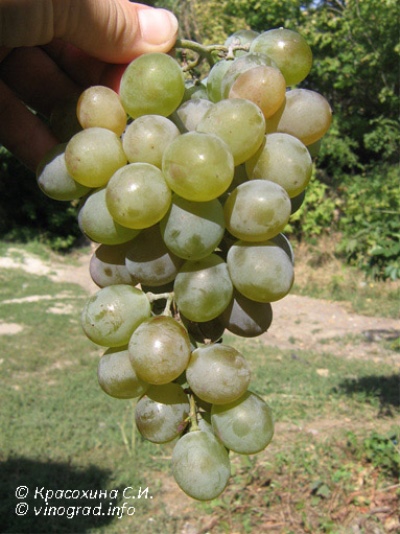
- Authors: USA
- Appointment: universal
- Berry color: light green with a yellowish tint
- Taste: isable
- Ripening period: average
- Frost resistance, ° C: -25
- Name synonyms: NY 10513
- Flower type: bisexual
- Density of the bunch: medium and loose
- Appeared when crossing: Lingyan blanc x Ontario
The Seneca grape may well live up to its wise, majestic name. But that is precisely why it needs to be studied very carefully and deeply. An important role is played by information about various practical, purely parameters.
Breeding history
The Seneca variety originated in the United States. The varieties of Ontario and Lingyan blanc were taken as a basis. Its alternative name is NY 10513. The culture is of a universal type. The variety is quite old - it was bred back in 1930.
Description
Ripening period
Seneca has an average time to ripeness. Fruit picking can take place in late August - early September. Pretty soon, the formation of new berries stops. The ripening of the shoots is very good. In fact, if gardeners did everything right in advance, they just have to not interfere with fruiting.
Bunches
The Seneca brushes are medium to large. They may have a wing, but it is small. The shape of the bunch is an ordinary cone. Loose or medium density structure is typical. This bunch looks attractive.
Berries
The share of sugar is 178 g per 1 dm3. The acidity level is 7 g per 1 dm3. The size of the grapes is quite large. Other features:
the main shape is an oblong oval;
light green color;
light yellowish tint;
fruit weight up to 5 g;
the presence of several seeds in individual berries.
Taste
Seneca has an isable shade. The fruit is characterized by a slimy pulp. Strawberry aroma is also noted. The palatability is suitable for both table and wine-making use.
Yield
The variety belongs to the high-yielding group. Fertility is fairly stable. Unfortunately, no clear figures are given anywhere. It can be assumed that this is due to the inapplicability of American data to the situation of the domestic climate.


Growing features
Landing
Most often, these grapes are planted in an arched formation. Trellis plantations are used much less often. It is worth considering that in the first 24 months after disembarkation, the growth rate will be low. However, then it will accelerate significantly. There is no other information on the order of landing.

Pollination
The bisexual flowers of the Seneca grape are quite capable of fertilizing each other themselves. There is simply no need for additional pollination. Attracting insects to the vineyard is necessary in exceptional cases. Usually bees are not needed at all.
Pruning
The plant is characterized by strong, fast growth. Normalizing and shaping it is very important. First of all, weak, diseased and deformed branches are removed. The second pruning is carried out 14 days after the end of the leaf fall. The air temperature at this moment should not be lower than –3 degrees.
Violation of this rule threatens the fragility of the grapes. In young seedlings, excess shoots are cut off every year. The formation scheme is selected at your discretion. Perennial Seneca bushes must be cut in several stages. The time intervals between trimming should be short.

Watering
The first moistening is carried out simultaneously with the application of fertilizers containing nitrogen. The next watering is done when the grape twigs reach a length of 25-30 cm. Adult bushes are watered with 10-25 liters of water. At the same time, the dimensions of the bush and the chemical composition of the earth are taken into account. Good irrigation is extremely important before flowering, as well as before the onset of winter.


Top dressing
In the spring, Seneca's complex mineral fertilizing is carried out. For 1 bush they use:
20 g superphosphate;
10 g ammonium nitrate;
5 g of potassium salts.
The first feeding may involve the use of rotted organic matter. To make it work faster, you need to prepare a solution. 14-21 days before the start of flowering, such a feed should be duplicated. Nitrogen fertilization is not needed at this moment. Before setting the berries, superphosphates and potassium sulfate are used.
An alternative can be the use of ash. It is also preferably used as a solution. For 1 bush, 5 liters of such a solution are used. Foliar dressing with microelements is also good, for example, using boric acid. After the end of fruiting, it should be used for feeding with nitroammofosk.
Frost resistance and the need for shelter
The tolerated temperature is –25 degrees. Therefore, everywhere, except for the warmest regions of Russia, Seneca will have to be sheltered in any case. There are few chances for its successful cultivation in the Urals and in more severe places. Organic rather than synthetic shelters are preferred.

Diseases and pests
The situation is as follows:
resistance to fungal infections is quite high;
phylloxera resistance is limited;
the likelihood of a mildew infection is small;
specific pests of this variety are not described.

If a grape is exposed to any disease or insect, this always affects its appearance.
Storage
In Russia, Seneca is used mainly for fresh consumption.In the United States and other countries, its crops are processed into wine. There are no special differences from other varieties during short-term storage. Or at least there is no information about it.











































































